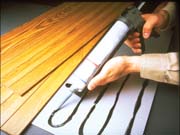

Recently, we developed a series of organic metal acrylates that are soluble in most monomers, which now lead to higher formulation capabilities. The new oligomers have been studied by Sartomer chemists in various applications.1-4 Due to their hydrophobic nature, the metal-containing oligomers can be used at high levels in standard radiation-curable formulations. The metal-containing oligomers described in this article have been shown to promote adhesion to metal and glass. It is anticipated that these products and products based on other metals will demonstrate high value performance, such as conductivity, high refractive index, anti-fungal properties, and more.

Metal Acrylate Compositions
Sartomer patents5, 6describe the synthesis of two types of soluble metal oligomers. Figure 1 shows the reaction for obtaining a polyester metal acrylate, and Figure 2 shows a urethane metal acrylate utilizing zinc oxide to provide the metal content in the synthesized oligomer.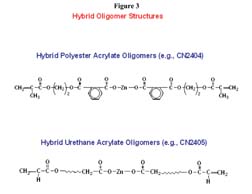
Discussion
For the past few years, our chemists have studied the new metal-containing oligomers and their benefits in different application areas. Bailey's work1,4discusses the benefits of reversible crosslinking in solvent-based and hot-melt pressure-sensitive adhesives (PSAs). Ceska reported2, 3on the use of the novel oligomers in radiation-curable coatings on several substrates. Also, the metal-containing hybrid oligomers have been evaluated in radiation-curable PSAs over the past four years. Each of these application areas will be covered in detail.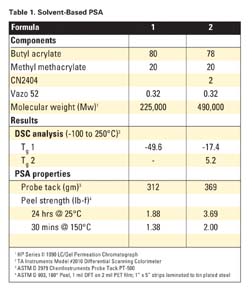
Solvent-Based PSAs
Bailey evaluated the new metal-containing oligomers in a solvent-based PSA formulation. He used CN2404 as a co-reactant in the preparation of a solvent-based PSA. Bailey found that the CN2404 improves adhesion to a broad range of substrates with excellent durability on exposure to moisture, heat, and ultraviolet light. Table 1 shows the sample formulations for a solvent-based PSA along with DSC and adhesive testing results. The metal-containing solvent-based PSA yielded higher tack and peel than the PSA not containing the metal.Hot-Melt PSAs
Bailey continued his studies using the metal acrylates in hot-melt pressure-sensitive adhesives (HM PSA). He found that the new oligomer introduced ionic crosslinks into the backbone. The ionic crosslinks yielded thermoset behavior and enhanced the adhesive properties at ambient temperature. At elevated temperatures, the crosslinks broke to yield thermoplastic behavior.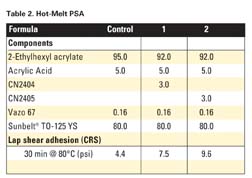
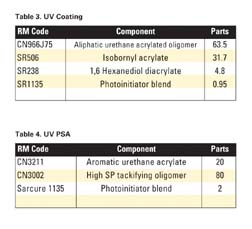
UV-Curable Coating
Ceska2, 3reported adhesion results for a UV-curable coating comparing the CN2404 and the CN2405. In this study, a base monomer, oligomer, and photoinitiator blend was prepared in which the zinc-containing oligomer was varied from 1 to 16 parts. The base formulation is shown in Table 3.

UV-Curable PSA
Both the CN2404 and the CN2405 were evaluated in UV-curable PSA formulations. A base formulation was made and then 2 and 6 parts of the metal acrylates were added to evaluate adhesion and tack of the PSA. The UV-curable PSA formulation is shown in Table 4.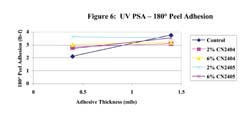
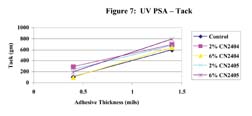
Conclusion
This article demonstrates the many different applications in which the new zinc-containing oligomers have been evaluated. The metal-containing crosslinking oligomers can be prepared and used as co-reactants for acrylic pressure-sensitive and hot-melt adhesives. The polymerizations can be done by both bulk and solution polymerization and still result in a free flossing tacky solid or solution. The use of zinc-containing oligomers in UV-cured coatings promoted adhesion to different metal and glass substrates. And when the zinc-containing oligomers were added into a base UV-curable PSA, both the 180º peel adhesion and tack were improved.These products represent a new raw material type for both peroxide- and radiation-curable systems, as well as crosslinking oligomers used in bulk and solution polymerization. The performance properties were improved in all applications. Additional work in both the application areas and new metal-containing molecules are active projects at Sartomer.
For more information on oligomers, contact Sartomer Co., 502 Thomas Jones Way, Exton, PA 19341; phone (610) 363-4100 or (800) SARTOMER (727-8663); fax (610) 363-4140; or visit http://www.sartomer.com .